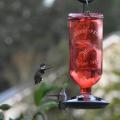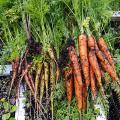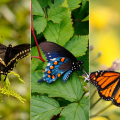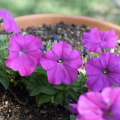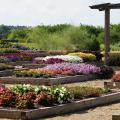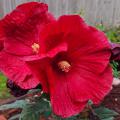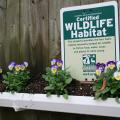News Filed Under Flower Gardens
If you are a sports fan -- or even if aren’t but don’t want to let that secret out -- one way to show off your allegiance is in the garden. There may not be a better way to combine interests than through a creative display that can include blooms, foliage and even garden art.
September and October have many home gardeners wondering what to do with their landscapes for the next couple of months. Summer annuals are nearly worn out, and the weather is still too warm for winter color to be established. I have found fall mums to be an ideal bridge crop.
Over the weekend, we had a most welcome visitor return to my home garden and landscape after an absence of several months. Our first hummingbird of the fall season arrived, and this was an indicator of lots of activity in the next few weeks. I get excited to see the first fall hummingbirds because it means they’re going to start gathering all along the Gulf Coast in preparation for their fall migration.
Even though we’re still in a very warm August, now is the time to start thinking about fall color. It can be a garden challenge trying to maintain a variety of color in the coming cool-season landscape. In my opinion, dianthus is one good choice to help keep your garden interesting, and it is an easy choice for that extra splash of cool-season color.
As the time nears for summer to turn to fall and temperatures drop, I get excited thinking about the changes this will bring to the landscape. Depending on where you garden in Mississippi, September, October and November can be filled with some of the brightest colors of the year.
After last week’s discussion of growing sunflowers in the fall season, I was inspired to consider what is involved in growing yellow flowers all year in most Mississippi gardens and landscapes. Obviously, different plants need to be selected for the different seasons, so I’ve put together a list of yellow flowers that you can enjoy through the year.
I think sunflowers fall into the category of sunny, summer royalty. One of the most striking sunflower sights I have ever seen was while driving through North and South Dakota on the way to Sturgis and Bike Week. There were miles and miles -- acres and acres -- of yellow sunflowers blooming for as far as the eye could see.
Simply walking out the front door each day, we’re reminded that it is a blistering hot summer season. But believe it or not, now is the time to start planning and getting ready for the fall vegetable garden. We’re only 36 days from the meteorological start of the fall gardening season.
As the host of Southern Gardening, I promote primarily ornamental landscape and garden plants through newspaper articles, TV segments and social media posts. So I find it interesting that most of the questions I receive revolve around the vegetable garden.
Butterflies are a fan-favorite insect among many people. Not only are they pleasing to watch, they also play a vital role in our environment. Butterflies are pollinators, meaning they move pollen from one flower to another, fertilizing plants so they can reproduce. They’re both beautiful AND beneficial!
One of my most enjoyable garden experiences involves plants that just randomly pop up in various places in my home garden and landscape. Some gardeners call these weeds, but many others call them volunteers. I love my plant volunteers, and I let them grow in some unexpected places around my landscape.
Petunias are great summer annuals to have in your landscape. They offer beautiful blooms that can withstand the Mississippi heat and thrive up until the first cold snap of the winter. Get the most out of your petunias by properly deadheading them! Deadheading the wilted or dead blooms only encourages new blooms to grow and keeps them looking great for several months.
One of my favorite ways to enjoy the garden and landscape is to buy various plants and make combination planting containers.
This is one of the easiest ways to have garden fun even in the hottest Mississippi summer. And this type of gardening works even if you don’t have any gardening space. All you need is a porch, patio or back deck.
Growing plants in containers also makes it easy to move the plants around to get more or less sun to meet their needs. Or you can simply move them to change the way your garden looks.
Some of my favorite summer flowering annuals are petunias. I like petunias because they tolerate our hot and humid Mississippi summer weather very well. There are great selections of petunias available in the garden centers, but I have to admit that I’m partial to Supertunias. These plants have never failed to be great performers in my home landscape.
Most gardens and landscapes are planned for either beauty or utility. We want pretty places to live in and look at, and we like to eat fresh fruit and produce that we have grown. But there are other reasons to prepare a garden or landscape. One of the most fun and rewarding reasons is to make room for butterflies and other pollinators.
CRYSTAL SPRINGS, Miss. -- Gardeners can enjoy a half-day horticulture event at the Mississippi State University Truck Crops Branch Experiment Station in Crystal Springs June 21.
If you like trumpet-shaped flowers, you may be familiar with both Mandevilla and Dipladenia, and you may even have them in your landscape. If you do, you probably realize they are very different, even if their blooms are a lot alike. Dipladenia and Mandevilla are both great choices for Mississippi landscapes.
Those who know me know I have lots of favorite plants because I don’t think anyone should be limited to just one or two choices. Today, I want to tell you about my late-spring to early-summer favorite, the hardy hibiscus.
Several years ago, many businesses and organizations began offering digital badges to replace the traditional certificates that signify the successful completion of some specialized, non-accredited course or workshop. These badges are icons or symbols that offer instant recognition of the expertise of the individual. If you’re a fan of social media like I am, then you certainly know about group badge icons.
There is a lot of attention being paid to helping Monarch butterflies, and why not? These amazing insects are the only butterfly species known to have a migration pattern much like birds. Using environmental cues, they migrate south in the fall to overwintering grounds in Mexico. In the spring, they migrate north to breeding grounds all across North America.



